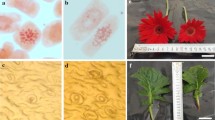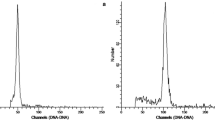Abstract
An effective chromosome doubling protocol was established in essential garden crop of cucumber (Cucumis sativus L.) Cv. Hi Power. The different concentrations of colchicine (0, 250, 500, 750, and 1500 mg/L), oryzalin (0, 5, 15, 25, 50, 75, and 150 mg/L) and trifluralin (0, 5, 15, 25, 50, 75, and 150 mg/L) were applied on parthenogenesis-induced haploid nodal and shoot tip explants of cucumber for 18 and 38 h in three independent factorial experiments. Increasing concentrations of applied antimitotic agents led to the significant reduction in the survival rate of both shoot tip and nodal explants, especially in longer exposure duration. Three ploidy levels including haploid, mixoploid, and doubled haploid were regenerated form both explant types treated with colchicine, oryzalin, and trifluralin. Flow cytometry analysis proved successful chromosome doubling of haploid plants. Based on the results obtained, the highest number of regenerated doubled haploid plants (92.31%) and fruit set (86.21%) were related to immersion of nodal explants in 50 mg/L oryzalin for 18 h. The highest doubled haploid regeneration for colchicine and trifluralin antimitotic agents were 58.33 and 83.33%, respectively. The leaf size of doubled haploid plants was larger than their correspond haploids. The optimized chromosome doubling protocol would be applicable for doubled haploid production in garden crops of Cucurbitaceae family, which is recalcitrant to the spontaneous doubling, and also for in vitro polyploidy induction studies.



Similar content being viewed by others
References
Abraha E, Klima M, Vyvadilova M, Bechyne M (2008) Effectiveness of selected antimitotic agents in microspore culture for Brassica carinata doubled haploid production. Agric Trop ET Subtrop 41(4):137–149
Agogbua JU, Ekeke C (2017) In vitro polyploidization of Zehneria capillacea (Shumach.) C. Jeffrey using nodal explants. J Adv Biol Biotechnol 13(2):1–13
Amiri S, Kazemitabaar SK, Ranjbar G, Azadbakht M (2010) The effect of trifluralin and colchicine treatments on morphological characteristics of Jimsonweed (Datura stramonium L.). Trak J Sci 8(4):47–61
Ascough GD, van Staden J (2008) Effectiveness of colchicine and oryzalin at inducing polyploidy in Watsonia lepida N.E. Brown. Hortic Sci 43(7):2248–2251
Bögre L, Calderini O, Binarova P, Mattauch M, Till S, Kieger S, Jonak C, Pollaschek C, Barker P, Huskisson NS, Hirt H, Heberle-Borsa E (1999) A MAP kinase is activated late in plant mitosis and becomes localized to the plane of cell division. Plant Cell 11:101–113
Bohanec B (2009) Doubled haploid via gynogenesis. In: Touraev A, Forster BP, Jain SM (eds) Advances in haploid production in higher plants. Springer, Berlin, pp 35–46
Caglar G, Abak K (1997) In vitro colchicine applications of haploid cucumber plants. Report 20:21–23
Claveria E, Garcia-Mas J, Dolcet-Sanjuan R (2005) Optimization of cucumber doubled haploid line production using in vitro rescue of in vivo induced parthenogenic embryos. J Am Soc Hortic Sci 130(4):555–560
Dhooghe E, Van Laere K, Eeckhaut T, Leus L, Van Huylenbroeck J (2011) Mitotic chromosome doubling of plant tissues in vitro. Plant Cell Tiss Organ Cult 104:329–341
Doi H, Hoshi N, Yamada E, Yokoi S, Nishihara M, Hikage T, Takahata Y (2013) Efficient haploid and doubled haploid production from unfertilized ovule culture of gentians (Gentiana spp.). Breed Sci 63:400–406
Dong YQ, Zhao WX, Li XH, Liu XC, Gao NN, Huang JH, Wang WY, Xu XL, Tang ZH (2016) Androgenesis, gynogenesis, and parthenogenesis haploids in cucurbit species. Plant Cell Rep 35(10):1991–2019
Dpooležel J, Binarová P, Lcretti S (1989) Analysis of nuclear DNA conten in plant cells by flow cytometry. Biol Plant 31:113–120
Ebrahimzadeh H, Shariatpanahi ME, Ahmadi B, Soltanloo H, Lotfi M, Zarifi E (2018) Efficient parthenogenesis induction and in vitro haploid plant regeneration in cucumber (Cucumis sativus L.) using putrescine, spermidine, and cycocel. J Plant Growth Regul pp. 1–8
Eeckhaut T, Samyn G, Van Bockstaele E (2001) In vitro polyploidy induction in Rhododendron simsiihybrids. Med Fac Landbouww 66:451–454
Falconer MM, Seagull RW (1987) Amiprophos-methyl (APM): a rapid, reversible, anti-microtubule agent for plant cell cultures. Protoplasma 136(2–3):118–124
Feng H, Wang ML, Cong RC, Dai SL (2017) Colchicinen and trifluralin-mediated polyploidization of Rosa multiflora Thunb. var. inermis and Rosa roxburghii f. normalis. The J Hortic Sci Biotechnol 9(3):1–9
Gémes Juhász A, Balogh P, Ferenczy A, Kristóf Z (2002) Effect of optimal stage of female gametophyte and heat treatment on in vitro gynogenesis induction in cucumber (Cucumis sativus L.). Plant Cell Rep 21:105–111
Geoffriau E, Kahane R, Bellamy C, Rancillac M (1997) Ploidy stability and in vitro chromosome doubling in gynogenic clones of onion (Allium cepa L.). Plant Sci 122(2):201–208
Gonzalo MJ, Claveria E, Monforte AJ, Dolcet-Sanjuan R (2011) Parthenogenic haploids in melon: generation and molecular characterization of a doubled haploid line population. J Am Soc Hortic Sci 136(2):145–154
Harbard JL, Griffin AR, Foster S, Brooker C, Kha LD, Koutoulis A (2012) Production of colchicine induced autotetraploids as a basis for sterility breeding in A. mangium Willd. Forestry 85:427–436
He Y, Sun Y, Zheng R, Ai Y, Cao Z, Bao M (2016) Induction of tetraploid male sterile Tagetes erecta by colchicine treatment and its application for interspecific hybridization. Hortic Plant J 2(5):284–292
Huang HP, Gao SL, Chen LL, Wei KH (2010) In vitro tetraploid induction and generation of tetraploids from mixoploidy in Dioscorea zingiberensis. Pharmacogn Mag 6:51–56
Jones JR, Ranney TG, Eaker TA (2008) A novel method for inducing polyploidy in rhododendron seedlings. J Am Rhododendron Soc 62:130–135
Kermani MJ, Sarasan V, Roberts AV, Yokoya K, Wentworth J, Sieber VK (2003) Oryzalin-induced chromosome doubling in Rosa and its effect on plant morphology and pollen viability. Theor Appl Genet 107(7):1195–1200
Klíma M, Vyvadilová M, Kučera V (2008) Chromosome doubling effects of selected antimitotic agents in Brassica napus microspore culture. Czech J Genet Plant Breed 44:30–36
Lim W, Earle ED (2008) Effect of in vitro and in vivo colchicine treatments on pollen production and fruit recovery on melon plants obtained after pollination with irradiated pollen. Plant Cell Tissue Org Cult 95(1):115–124
Lim W, Earle ED (2009) Enhanced recovery of doubled haploid lines from parthenogenetic plants of melon (Cucumis melo L.). Plant Cell Tissue Org Cult 98:351–356
Lin H, Jian M, Liang LY, Pei WJ, Liu XZ, Zhang HY (2010) Production of polyploids from cultured shoot tips of Eucalyptus globulus Labill by treatment with colchicine. Afr J Biotechnol 9(15):2252–2255
Lotfi M, Alan AR, Henning MJ, Jahn MM, Earle ED (2003) Production of haploid and doubled haploid plants of melon (Cucumis melo L.) for use in breeding for multiple virus resistance. Plant Cell Rep 21:1121–1128
Melchinger AE, Molenaar WS, Mirdita V, Schipprack W (2016) Colchicine alternatives for chromosome doubling in maize haploids for doubled-haploid production. Crop Sci 56:559–569
Niazian M, Noori SAS, Galuszka P, Tohidfar M, Mortazavian SMM (2017) Genetic stability of regenerated plants via indirect somatic embryogenesis and indirect shoot regeneration of Carum copticum L. Ind Crops Prod 97:330–337
Noori SAS, Norouzi M, Karimzadeh G, Shirkool K, Niazian M (2017) Effect of colchicine-induced polyploidy on morphological characteristics and essential oil composition of ajowan (Trachyspermum ammi L.). Plant Cell Tissue Organ Cult 130:543–551
Ochatt SJ, Patat-Ochatt EM, Moessner A (2011) Ploidy level determination within the context of in vitro breeding. Plant Cell Tiss Organ Cult 104:329–341
Pintos B, Manzanera JA, Bueno MA (2007) Antimitotic agents increase the production of doubled-haploid embryos from cork oak anther culture. J Plant Physiol 164:1595–1604
Przyborowski JA, Niemirowicz-Szczytt K (1994) Main factors affecting cucumber (Cucumis sativus L.) haploid embryo development and haploid plant characteristics. Plant Breed 112:70–75
Rahman M, Jiménez MM (2016) Behind the scenes of microspore-based double haploid development in Brassica napus: A review. J Plant Sci Mol Breed 5:1–5. https://doi.org/10.7243/2050-2389-5-1
Rêgo MD, Rêgo ER, Bruckner CH, Finger FL, Otoni WC (2011) In vitro induction of autotetraploids from diploid yellow passion fruit mediated by colchicine and oryzalin. Plant Cell Tissue Organ Cult 107(3):451–459
Sari N, Abak K (1996) Effect of colchicine treatment with different doses and periods on in vitro chromosome duplication in haploid watermelon. Turk J Agric For 20(6):555–559
Sauton A, Dumas de Vaulx R (1987) Production of haploid plants in melon (Cucumis melo L.) as a result of gynogenesis induced by irradiated pollen. Agronomie 7(2):141–147
Shariatpanahi ME, Ahmadi B (2016) Isolated microspore culture and its applications in plant breeding and genetics. In: Anis M, Ahmad N (eds) Plant tissue culture: propagation, conservation and crop improvement. Springer, Singapore, pp 487–507
Sood S, Dwivedi S, Reddy TV (2013) Improving androgenesis-mediated doubled haploid production efficiency of FCV tobacco (Nicotiana tabacum L.) through in vitro colchicine application. Plant Breed 132:764–771
Wan Y, Duncan DR, Rayburn AL, Petolino JF, Widholm JM (1991) The use of antimicrotubule herbicides for the production of doubled haploid plants from anther-derived maize callus. Theor Appl Genet 81:205–211
Würschum T, Tucker MR, Reif JC, Maurer HP (2012) Improved efficiency of doubled haploid generation in hexaploid triticale by in vitro chromosome doubling. BMC Plant Biol 12(109):3–7
Zhang QY, Luo FX, Liu L, Guo FC (2010a) In vitro induction of tetraploids in crape myrtle (Lagerstroemia indica L.). Plant Cell Tissue Organ Cult 101:41–47
Zhou HW, Zeng WD, Yan HB (2017) In vitro induction of tetraploids in cassava variety ‘Xinxuan 048’ using colchicine. Plant Cell Tissue Org 128:723–729
Zlesak D, Thill C, Anderson N (2005) Trifluralin-mediated polyploidization of Rosa chinensis minima (Sims) Voss. Euphytica 141:281–290
Acknowledgements
This research was supported by grants from Agricultural Biotechnology Research Institute of Iran (ABRII) Project No. 12-05-05-9451-94001.
Author information
Authors and Affiliations
Contributions
HE contributed in the practical process of parthenogenesis induction, regeneration of plants, chromosome doubling, cytological and flow cytometer analysis. HS and MES (corresponding authors) contributed in the supervising of the whole process. AE contributed in the pollen irradiation experiments. SSR contributed in data analysis.
Corresponding authors
Ethics declarations
Conflict of interest
The authors declare that they have no conflict of interests.
Additional information
Communicated by Maria Antonietta Germanà.
Rights and permissions
About this article
Cite this article
Ebrahimzadeh, H., Soltanloo, H., Shariatpanahi, M.E. et al. Improved chromosome doubling of parthenogenetic haploid plants of cucumber (Cucumis sativus L.) using colchicine, trifluralin, and oryzalin. Plant Cell Tiss Organ Cult 135, 407–417 (2018). https://doi.org/10.1007/s11240-018-1473-y
Received:
Accepted:
Published:
Issue Date:
DOI: https://doi.org/10.1007/s11240-018-1473-y




